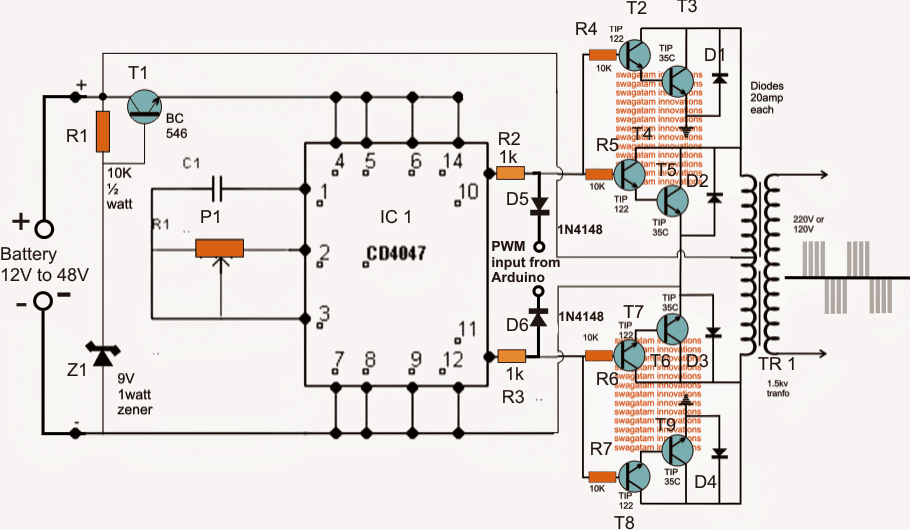In this post I have explained how to interface an existing Arduino PWM signal with any inverter to convert it into a sine wave equivalent inverter. The idea was requested by Mr. Raju Visshwanath
Technical Specifications
I am in need of following inverter circuit designs:
Single phase DC to AC inverter. Input 230 VDC. PWM signals will be sent from Arduino Uno.
Three phase DC to AC inverter. Input 230 VDC. PWM signals will be sent from Arduino Uno.
Can you please let me know your estimated service charges, lead time and payment terms?
Thank you,
Raju Visshwanath
UPDATE:
Please also refer to this article which explains how to build a simple pure sine wave inverter circuit using Arduino using SPWM......Full Program code also included....
The Design
As per the request the first diagram below shows a single phase PWM sine wave inverter using an Arduino feed for the PWMs.
The design looks pretty simple, the 4047 IC is configured as a totem pole astable for generating the basic 50 Hz or 60 Hz frequency.
This frequency drives the two power BJ transistor stages alternately at the specified frequency rate.
The transistors could be replaced with IGBTs for getting better efficiency, but mosfets should be avoided as these may require special attention while designing the PCB, and additional buffer BJT stages to prevent heating up of the mosfets from possible hidden stray inductance or harmonics.


Circuit Operation
In the above diagram P1 and C1 determine the frequency of the astable which can be adjusted by suitably setting up P1 using a frequency meter for the intended inverter operating frequency.
T1 and the associated components which stabilize a fixed 9V for the IC 4047 may be eliminated if the selected inverter operating voltage is not over 15V, however higher voltage up to 60V could be tried and is recommended for achieving a compact and a more powerful inverter design.
The PWM from the Arduino is applied across voltage divider networks over the two outputs of the IC via reverse biased diodes which make sure that only the negative pulses of the PWMs interact with the power stages and chop their conduction appropriately.
As a result of these PWM chopping effect, the induced current inside the transformer is also correspondingly shaped for achieving the intended PWM sinewave stepped up mains voltage at the secondary of the transformer.
The PWM frequency from the Arduino must be set at around 200 Hz, if a programmed 50 Hz totem pole is available from the Arduino then the IC4047 can be entirely eliminated and the signals can be integrated directly with R2, R3 left side ends.
would you mind helping me by sending me the details and the whole circuit diagrams of pure sine wave inverter 12vdc to 220vac?
if you wouldn’t please send to my email
you can try this:
Arduino Pure Sine Wave Inverter Circuit with Full Program Code
This can kind of all be done using software such as SPWM on github
without feedback and SPWM, sine wave and regulated output doesn't seem viable very difficult without MCU or baba Oscillator with CD4047BC Monostable/Astable Multivibrator diffidently impossible.
very difficult without MCU or baba Oscillator with CD4047BC Monostable/Astable Multivibrator diffidently impossible.